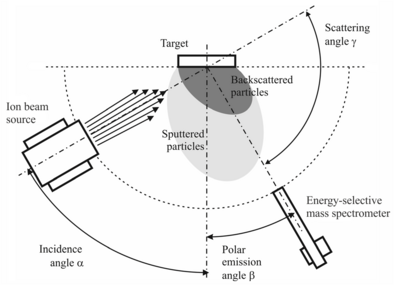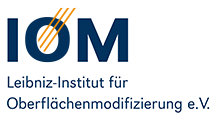The interdepartmental unit is engaged in fundamental research of the ion-solid interaction as well. This comprises direct measurements of ion sputter yields in the energy range of 100 to 1000 eV which is essential for engineering materials with ions as well as electric propulsion. Combining ion sputtering with in-situ X-ray diffraction allows the phase analysis of thin films with a depth resolution < 50 nm. Furthermore, secondary particles emitted under ion irradiation are characterised (species, energy and angular distribution of atoms and molecules as well as secondary electrons). These investigations are of interest, for example, for thin film deposition. In order to improve the understanding of processes in high-energy electron irradiation, fundamentals of modelling the 3D dose and heat distribution are investigated.



Expertise
- Characterisation of secondary particle emission under ion irradiation
- Determination of ion sputter yields
- Combination of ion bombardment with in situ X-ray diffraction
- Fundamentals of thin film growth using ion beam sputter deposition and plasma processes
- Fundamentals of electron beam irradiation (dose and heat distribution)
Highlights
Energy distributions of secondary ions for the Ar ion beam sputtering of indium tin oxide
C. Bundesmann, A. Hellmich
J. Vac. Sci. Technol. B 38 (2020) 064002
DOI: 10.1116/6.0000516The energy distributions of secondary ions for the Ar ion beam sputtering of indium tin oxide were measured in dependence on geometric parameters (ion incidence angle, polar emission angle, scattering angle), ion energy, and O2 background pressure using energy-selective mass spectrometry. The most prevalent ion species were identified to be O+, O2+, Ar+, In+, and Sn+. The energy distributions of O+, In+, and Sn+ ions show a low-energy maximum between 10 and 20 eV, followed by a power-law decay if the scattering angle is γ > 90°. If γ < 90°, an additional high-energy structure evolves, which is assigned to anisotropy effects, namely, directly sputtered particles. The energy distributions of the Ar+ ions show a low-energy maximum and, in dependence on the scattering angle, up to two additional high-energy structures, which are also assigned to anisotropy effects. Here it is related to direct scattering events. All additional structures show systematic correlations with scattering angle and ion energy. The energy distributions of the O2+ ions exhibit a low-energy maximum followed by a sudden signal drop. There is almost no variation with scattering angle or ion energy. In general, increasing the O2 background pressure results in a decrease of the particle energy due to interaction with background gas particles. The experimental results are compared and discussed with calculations based on elastic two-particle collision theory and using SRIM, and Monte Carlo simulations using SDTrimSP.
Properties of secondary particles for the reactive ion beam sputtering of Ti and TiO2 using oxygen ions
T. Amelal, L. Pietzonka, E. Rohkamm C. Bundesmann
J. Vac. Sci. Technol. A 38 (2020) 033403
DOI: 10.1116/1.5142911The ion beam sputtering of a metallic Ti and a ceramic TiO2 target by bombardment with oxygen ions was investigated systematically. Emphasis was put on the properties of the secondary particles emitted from the target, namely, the angular distribution of the sputtered Ti and the energy distribution of the secondary ions. Ion energies of 0.5, 1.0, and 1.5 keV and incidence angles of 0°, 30°, and 60° were used. The angular distribution of the flux of sputtered Ti particles was determined by measuring the thickness of TiO2 films that were deposited under emission angles in the range between −40° and +80°. An empirical formula was used to describe the angular distribution as a superposition of an isotropic and an anisotropic cosine-like function. Increasing the ion energy or decreasing the ion incidence angle leads to a more isotropic emission of the sputtered Ti particles. The mass and energy distribution of the secondary ions were measured using an energy-selective mass spectrometer. The most prevalent ion species are O+, O2+, Ti+, and TiO+. Ion energy and sputtering geometry, i.e., the combination of an ion incidence angle and an emission angle, were found to have a strong influence on the energy distribution of the secondary ions.
Perspective: In situ XRD measurements to explore phase formation in the near surface region
D. Manova, S. Mändl
J. Appl. Phys. 126 (2019) 200901
https://doi.org/10.1063/1.5126636Although X-ray diffraction (XRD) is a well-established, but still evolving, technique to characterize thin films and diffusion layers, there are two inherent limitations due to the underlying physical principles leading to diffraction: (i) all data are a weighted integral over the depth of information and (ii) X-ray amorphous or nanocrystalline phases are very difficult to detect. A simple combination of in situ XRD with depth profiling using a laboratory experiment in combination with a low energy broad beam ion source can overcome these limitations for functional surfaces. While time-resolved studies of diffusion and phase formation during ion implantation with reactive species are well established, the use of ion beam sputtering with non-reactive species for depth profiling of phase composition during measurements is a relatively new development. Analysis of difference spectra allows depth resolution of 50 nm or better - well below the typical depth of information. At the same time, successive ablation allows analysis of layers significantly thicker than the information depth.
Dynamic determination of secondary electron emission using a calorimetric probe in a plasma immersion ion implantation experiment
F. Haase, D. Manova, D. Hirsch, S. Mändl, H. Kersten
Plasma Sources Sci. Technol. 27 (2018) 044003
DOI: 10.1088/1361-6595/aabb2dA passive thermal probe has been used to detect dynamic changes in the secondary electron emission (SEE) from oxidized and nitrided materials under argon ion sputtering in a plasma immersion ion implantation process. Energy flux data were combined with scanning electron microscopy images of the surface to obtain information about the actual surface composition as well as trends and changes during the process. Within the measurements, a direct comparison of the SEE within both employed ion species (argon and nitrogen) is possible while an absolute quantification is still open. Nevertheless, the oxides showed a remarkably higher SEE compared to the pure metals, while an indistinct behavior was observed for the nitrides. The presented method is a versatile technique for measuring dynamic changes of the surface for materials commonly used in PVD processes with a time resolution of about 1 min, e.g. magnetron sputtering or HiPIMS, where changes in the target or electrode composition are occurring but cannot be measured directly.
